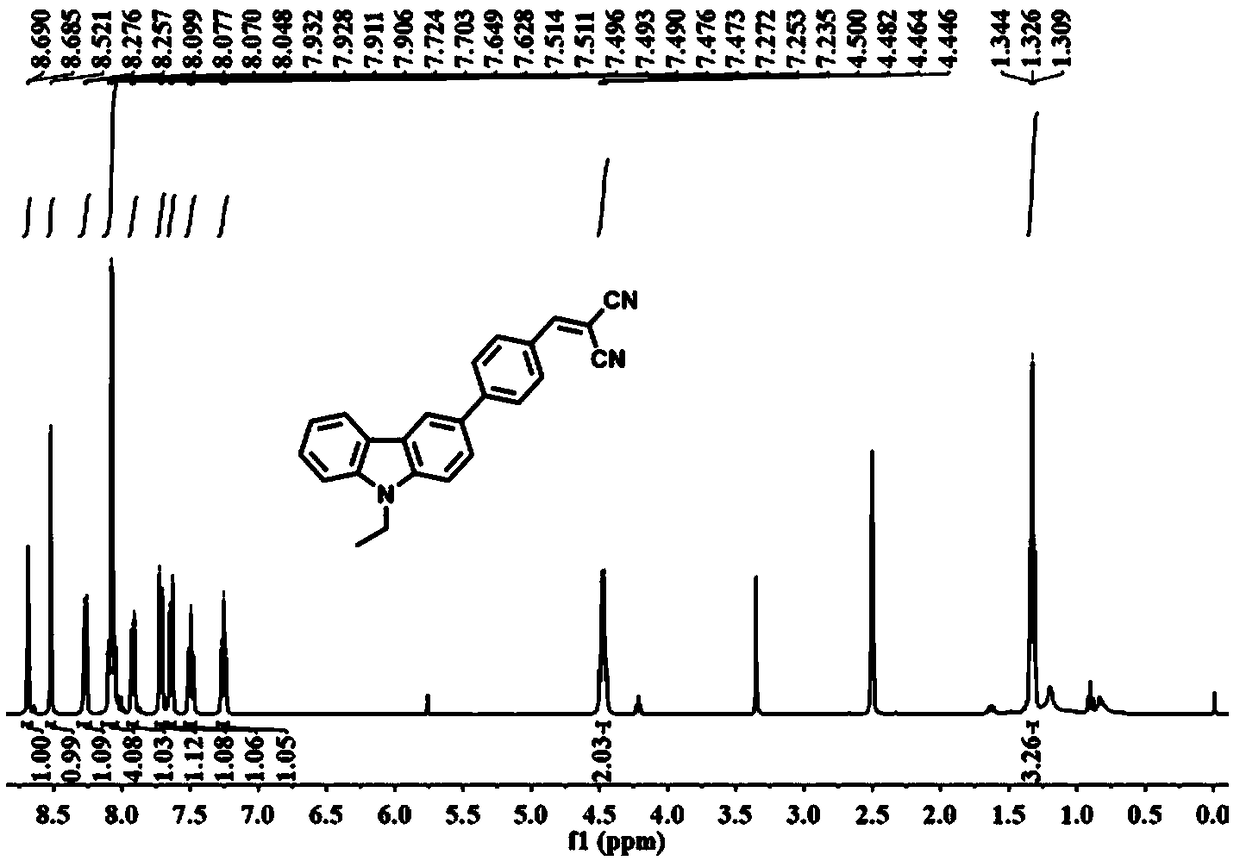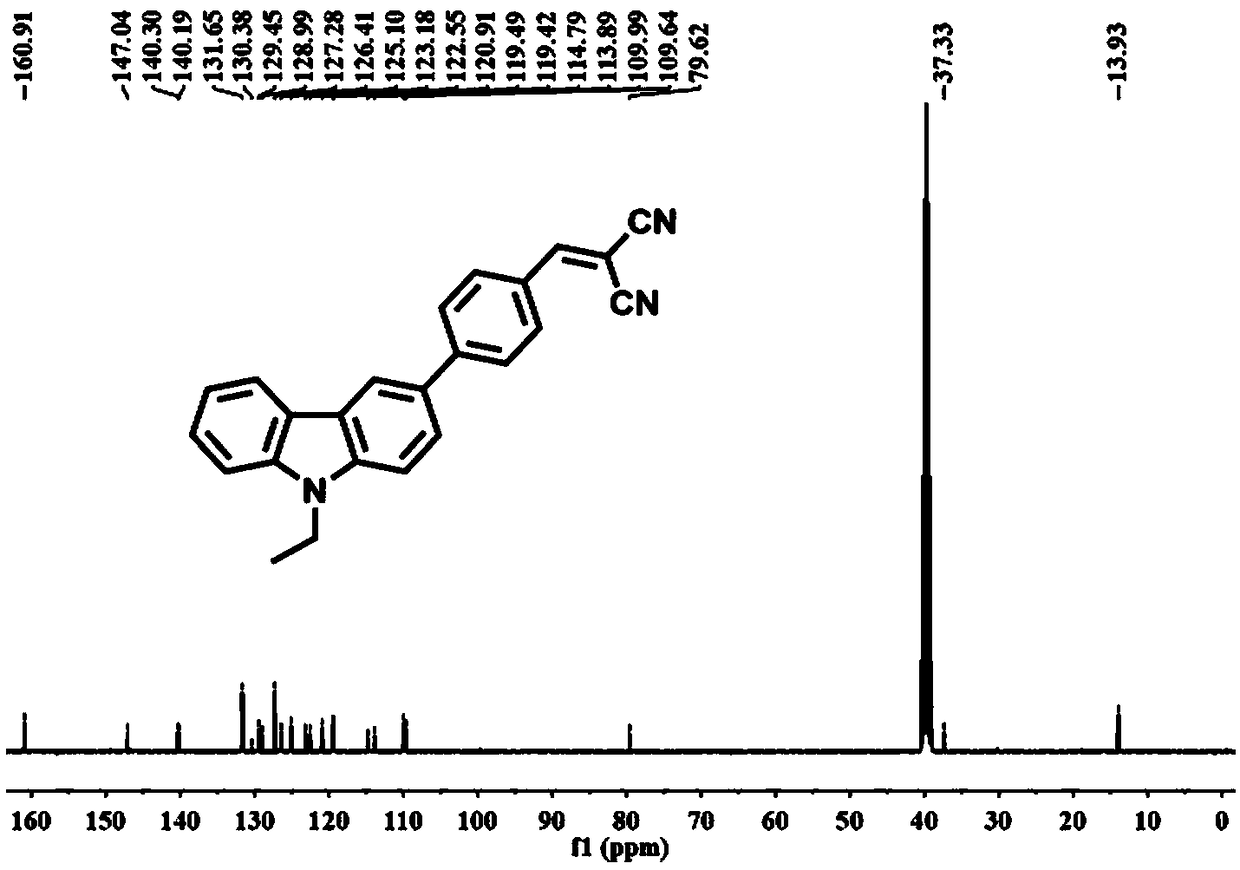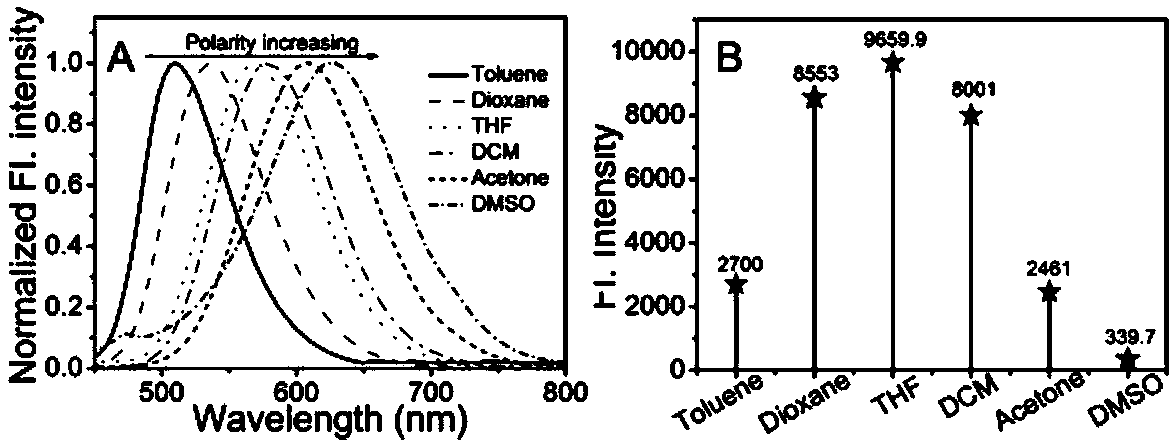Fluorescent probe for detecting polarity of lipid droplets and preparation method and application thereof
A fluorescent probe, lipid droplet technology, applied in fluorescence/phosphorescence, chemical instruments and methods, luminescent materials, etc., can solve the problems of invasive operation, inconvenient wide application, etc., achieve high yield, good polarity specificity Sexually responsive, step-by-step effect
- Summary
- Abstract
- Description
- Claims
- Application Information
AI Technical Summary
Problems solved by technology
Method used
Image
Examples
Embodiment 1
[0040] Example 1 Synthesis of fluorescent probe EBMC
[0041] (1) Synthesis of compound (3)
[0042]
[0043] Add 2.46 g of 3-bromocarbazole (10 mmol) (1) and 0.8 g of sodium hydroxide (20 mmol) into a high-pressure tube containing 20 mL of tetrahydrofuran, stir at room temperature, and add 6.56 g of bromoethane (60 mmol ), reacted for about 12h, after the reaction was completed, the system after the reaction was distilled under reduced pressure, and the solvent was spin-dried to obtain the crude product, and the mobile phase was separated and purified by column chromatography with ethyl acetate and petroleum ether at a volume ratio of 1:30 to obtain 3-Bromo-9-ethylcarbazole (3);
[0044] (2) Synthesis of compound (5):
[0045]
[0046] Weigh 0.274 g 3-bromo-9-ethylcarbazole (3) (1 mmol), 0.18 g 4-formylphenylboronic acid (4) (1.2 mmol), 37 mg tetrakis-(triphenylphosphine palladium) (0.03 mmol ), 0.445g potassium carbonate (3.23 mmol) in the mixed solvent of tetrahydr...
Embodiment 2
[0053] Example 2 Emission spectra of fluorescent probes in different solvents
[0054] A test mother solution of dimethyl sulfoxide (DMSO) with a concentration of 1 mM fluorescent probe EBMC obtained in Example 1 was prepared for use.
[0055] In the test solution, take 3 mL solvents of different polarities: toluene (Toluene), dioxane (Dioxane), tetrahydrofuran (THF), dichloromethane (DCM), acetone (Acetone), dimethyl sulfoxide ( DMSO), then add the probe mother solution with a concentration of 1mM, so that the final concentration of the probe in the test solution is 10 μM, and then perform fluorescence scanning (excitation wavelength 455nm, detection band 450-800nm) to obtain the fluorescence intensity in each system, such as image 3 shown. Depend on image 3 It can be seen that as the polarity of the solvent increases, the spectrum red shifts. Before the tetrahydrofuran solution, the fluorescence intensity increases with the increase of the polarity; after the tetrahydrof...
Embodiment 3
[0056] Example 3 Co-localization of fluorescent probes and commercial lipid droplet dyes
[0057] Preparation concentration is the test mother solution of the dimethyl sulfoxide (DMSO) of fluorescent probe EBMC obtained in embodiment 1 of 1 mM stand-by; The test mother liquor of sulfoxide (DMSO) is ready for use.
[0058] Inoculate an appropriate density of mouse mammary tumor cell 4T1 into a sterilized 35 mm imaging culture dish in CO 2 Incubator (at 37°C, 5% CO 2 ), after the cells were attached to the wall, the fluorescent probe EBMC and the lipid droplet commercial dye Nile Red were added to the cells at the same time, so that the final concentration of the fluorescent probe was 10 μM, and the final concentration of Nile Red was 5 μM. Half an hour later, discard the medium, wash the cells with PBS buffer three times, and then perform fluorescence imaging (excitation wavelength: 488 nm, green channel 500-550nm; excitation wavelength: 561nm, red channel 570nm-620nm), the i...
PUM
 Login to View More
Login to View More Abstract
Description
Claims
Application Information
 Login to View More
Login to View More - R&D
- Intellectual Property
- Life Sciences
- Materials
- Tech Scout
- Unparalleled Data Quality
- Higher Quality Content
- 60% Fewer Hallucinations
Browse by: Latest US Patents, China's latest patents, Technical Efficacy Thesaurus, Application Domain, Technology Topic, Popular Technical Reports.
© 2025 PatSnap. All rights reserved.Legal|Privacy policy|Modern Slavery Act Transparency Statement|Sitemap|About US| Contact US: help@patsnap.com



